IOL exchange technique corrects postop surprises
The method can restore patient satisfaction with quality of vision after premium IOL surgery.
Click Here to Manage Email Alerts
 Thomas John |
Ophthalmic surgeons who provide state-of-the-art technology, namely premium IOLs, to their patients when performing cataract surgery should be prepared to fully deliver and meet patient expectations for overall quality of vision after surgery. If a patient is dissatisfied with the IOL implant, then all options should be considered to rectify the problem, including refractive surgery to correct the residual refractive error or even IOL exchange. In some cases, refractive surgery may not be possible due to corneal parameters, and the only option may be IOL exchange. Hence, it is important for ophthalmic surgeons to be familiar with IOL exchange techniques that can be safely executed in such circumstances to convert an unhappy patient to a fully satisfied patient.
In this column, Drs. Guenena and Solomon describe a useful technique to safely remove the existing IOL and replace it with the desired lens to improve patient satisfaction and quality of vision.
Thomas John, MD
OSN Surgical Maneuvers Editor
Today, IOL exchanges can readily be made using proper surgical techniques. It is important in the era of premium IOLs (eg, toric, multifocal and accommodative lenses) that all surgeons be adept and comfortable with the proper techniques.
Surgical technique
Our technique entails performing one or two stab incisions with a 1-mm side-port blade, as well as using a 2.4- or 3-mm clear corneal keratome for creating the main incision. We prefer to use a dispersive viscoelastic agent such as VisCoat (chondroitin sulfate, sodium hyaluronate; Alcon) on a 30-gauge needle to initiate viscodissection, separating the anterior and posterior lens capsule. The 30-gauge needle is placed gently under the anterior capsular flap with the opening of the needle directed upward to inject the viscoelastic peripheral to the lens (Figure 1).
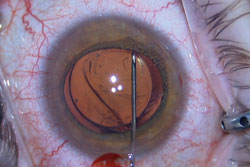 Figure 1. The anterior capsule is separated from the IOL using a 30-gauge needle. Images: Guenena MA, Solomon KD
|
As the capsular adhesions are broken, the capsule separates and opens. Periodic evacuation of the viscoelastic with automated irrigation and aspiration is necessary to avoid overfilling the eye with viscoelastic. After the capsule is opened, the side-port incision can be used to continue the 360º opening of the remaining capsular bag assisted with the viscoelastic.
Freeing the haptics
Once the bag is felt to be opened, a direct inspection and gentle movement of the lens can reveal whether the IOL haptics are completely free peripherally. In this case, the distal haptic was free and was easily brought to the anterior chamber while the proximal haptic was not, due to adhesions surrounding the peripheral bulb of the IOL haptic. For the proximal haptic to be removed, the surgeon has a choice of either amputating the haptic or trying to gently free it from the capsular adhesions. We chose to complete an additional paracentesis and inject viscoelastic along the proximal haptic (Figure 2).
We directed the viscoelastic toward the distal bulb, and with gentle manipulation, the proximal haptic was freed from the adhesions. At this point the haptic can be pulled and the lens easily positioned in the anterior chamber (Figure 3). Viscoelastic should again be placed anterior and posterior to the IOL to protect the cornea and the capsular bag.
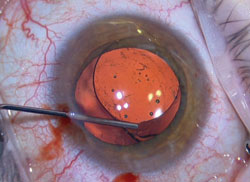 Figure 2. Viscoelastic dissection of the distal bulb of the proximal haptic frees it from adhesions. |
 Figure 3. The proximal haptic is pulled and the IOL is positioned in the anterior chamber. |
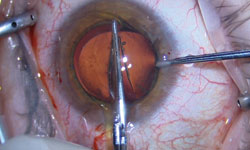 Figure 4. The lens is held with Mackool forceps that were introduced through a paracentesis, while the lens is cut in half using Mackool scissors, which had been passed through the main incision. |
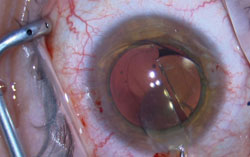 Figure 5. Each half of the IOL is removed using the distal end of the Mackool scissors, which can also be used as forceps. |
Using the Mackool cutting instruments, the lens is held with the Mackool forceps introduced through the side-port incision. The Mackool scissors are then advanced through the main incision, cutting the lens in half (Figure 4). The distal part of the scissors are forceps that can be used to grasp each half of the cut lens, removing it from the eye through the main incision (Figure 5).
Following the removal of the IOL, the capsular bag is refilled with a cohesive viscoelastic — in this case, ProVisc (1% sodium hyaluronate, Alcon). The new IOL is then implanted using Alcon’s D cartridge and Monarch III injector (Figure 6).
Removing viscoelastic
Automated I&A is then used to readily remove the remaining viscoelastic. Care must be taken to remove the dispersive viscoelastic as thoroughly as possible, but we intentionally leave a small quantity of the viscoelastic in the anterior chamber. The advantage is that the thin layer of dispersive viscoelastic acts as deturgescence, helping to keep the cornea thin and clear. We find this approach to be well-tolerated, and it does not usually lead to postoperative IOP spikes.
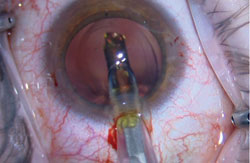 Figure 6. The new IOL is implanted using a D cartridge and a Monarch III injector. |
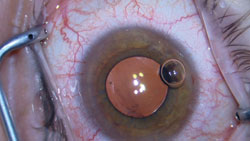 Figure 7. The end of the procedure shows the new IOL well-centered in the bag with a nice capsular rim surrounding its edge. |
At the end of the procedure, the new IOL should be centered in the capsular bag with a rim of anterior capsule surrounding it (Figure 7). This is ideal for long-term capsular fixation as well as a stable and predictable postoperative refractive outcome.
Adopting this approach can easily solve postoperative surprises and help dissatisfied patients by simply addressing the problem, whether it is a biometry surprise or just a patient that cannot tolerate some of the visual symptoms associated with multifocal IOLs. Postponing YAG capsulotomy until the surgeon can exclude the possibility of an IOL exchange in the near future is recommended and can help make this procedure easier and prevent complications when proper techniques are used.
References:
- Galor A, Gonzalez M, Goldman D, O’Brien TP. Intraocular lens exchange surgery in dissatisfied patients with refractive intraocular lenses. J Cataract Refract Surg. 2009;35(10):1706-1710.
- Karamaounas N, Kourkoutas D, Prekates C. Surgical technique for small-incision intraocular lens exchange. J Cataract Refract Surg. 2009;35(7):1146-1149.
- Thomas John, MD, OSN Cornea/External Disease Board Member, is a clinical associate professor at Loyola University Chicago and is in private practice in Tinley Park and Oak Lawn, Ill. He can be reached at 708-429-2223; fax: 708-429-2226; e-mail: tjcornea@gmail.com.
- Mohamed A. Guenena, MD, and Kerry D. Solomon, MD, can be reached at Carolina Eyecare Physicians, 1280 Johnnie Dodds Blvd., Suite 100, Mount Pleasant, SC 29464; 843-881-3937; fax: 843-884-8587; e-mail: kerry.solomon@carolinaeyecare.com. Dr. Solomon is a paid consultant to Alcon but has no financial interest in any aspect of this article.
- The authors would like to thank James P. Byrnes for video-editing assistance.

